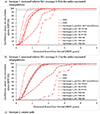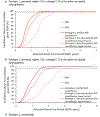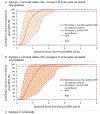Modeling Undetected Live Poliovirus Circulation After Apparent Interruption of Transmission: Pakistan and Afghanistan
- PMID: 30296340
- PMCID: PMC7842182
- DOI: 10.1111/risa.13214
Modeling Undetected Live Poliovirus Circulation After Apparent Interruption of Transmission: Pakistan and Afghanistan
Abstract
Since most poliovirus infections occur with no paralytic symptoms, the possibility of silent circulation complicates the confirmation of the end of poliovirus transmission. Based on empirical field experience and theoretical modeling results, the Global Polio Eradication Initiative identified three years without observing paralytic cases from wild polioviruses with good acute flaccid paralysis surveillance as an indication of sufficient confidence that poliovirus circulation stopped. The complexities of real populations and the imperfect nature of real surveillance systems subsequently demonstrated the importance of specific modeling for areas at high risk of undetected circulation, resulting in varying periods of time required to obtain the same level of confidence about no undetected circulation. Using a poliovirus transmission model that accounts for variability in transmissibility and neurovirulence for different poliovirus serotypes and characterizes country-specific factors (e.g., vaccination and surveillance activities, demographics) related to wild and vaccine-derived poliovirus transmission in Pakistan and Afghanistan, we consider the probability of undetected poliovirus circulation for those countries once apparent die-out occurs (i.e., in the absence of any epidemiological signals). We find that gaps in poliovirus surveillance or reaching elimination with borderline sufficient population immunity could significantly increase the time to reach high confidence about interruption of live poliovirus transmission, such that the path taken to achieve and maintain poliovirus elimination matters. Pakistan and Afghanistan will need to sustain high-quality surveillance for polioviruses after apparent interruption of transmission and recognize that as efforts to identify cases or circulating live polioviruses decrease, the risks of undetected circulation increase and significantly delay the global polio endgame.
Keywords: Disease eradication; disease outbreaks; disease surveillance; environmental surveillance; infection transmission modeling; poliomyelitis; poliovirus; vaccination.
© 2018 Society for Risk Analysis.
Figures







Similar articles
-
Modeling Undetected Live Poliovirus Circulation After Apparent Interruption of Transmission: Borno and Yobe in Northeast Nigeria.Risk Anal. 2021 Feb;41(2):303-311. doi: 10.1111/risa.13486. Epub 2020 Apr 29. Risk Anal. 2021. PMID: 32348634 Free PMC article.
-
Modeling undetected live poliovirus circulation after apparent interruption of transmission: implications for surveillance and vaccination.BMC Infect Dis. 2015 Feb 18;15:66. doi: 10.1186/s12879-015-0791-5. BMC Infect Dis. 2015. PMID: 25886823 Free PMC article.
-
Evaluation of Proactive and Reactive Strategies for Polio Eradication Activities in Pakistan and Afghanistan.Risk Anal. 2019 Feb;39(2):389-401. doi: 10.1111/risa.13194. Epub 2018 Sep 21. Risk Anal. 2019. PMID: 30239026 Free PMC article.
-
Breaking the Last Chains of Poliovirus Transmission: Progress and Challenges in Global Polio Eradication.Annu Rev Virol. 2018 Sep 29;5(1):427-451. doi: 10.1146/annurev-virology-101416-041749. Epub 2018 Jul 12. Annu Rev Virol. 2018. PMID: 30001183 Review.
-
[Polio, the long walk to the endgame].Enferm Infecc Microbiol Clin. 2015 Dec;33(10):e69-78. doi: 10.1016/j.eimc.2014.10.005. Epub 2015 Jan 13. Enferm Infecc Microbiol Clin. 2015. PMID: 25595690 Review. Spanish.
Cited by
-
Review of Poliovirus Transmission and Economic Modeling to Support Global Polio Eradication: 2020-2024.Pathogens. 2024 May 22;13(6):435. doi: 10.3390/pathogens13060435. Pathogens. 2024. PMID: 38921733 Free PMC article. Review.
-
Modeling undetected poliovirus circulation following the 2022 outbreak in the United States.Expert Rev Vaccines. 2024 Jan-Dec;23(1):186-195. doi: 10.1080/14760584.2023.2299401. Epub 2024 Jan 4. Expert Rev Vaccines. 2024. PMID: 38164695 Free PMC article.
-
Coordinated global cessation of oral poliovirus vaccine use: Options and potential consequences.Risk Anal. 2024 Feb;44(2):366-378. doi: 10.1111/risa.14158. Epub 2023 Jun 21. Risk Anal. 2024. PMID: 37344934 Free PMC article. Review.
-
Modeling scenarios for ending poliovirus transmission in Pakistan and Afghanistan.Risk Anal. 2023 Apr;43(4):660-676. doi: 10.1111/risa.13983. Epub 2022 Jun 23. Risk Anal. 2023. PMID: 35739080 Free PMC article.
-
Modeling undetected live type 1 wild poliovirus circulation after apparent interruption of transmission: Pakistan and Afghanistan.Risk Anal. 2023 Apr;43(4):677-685. doi: 10.1111/risa.13982. Epub 2022 Jun 23. Risk Anal. 2023. PMID: 35739067 Free PMC article.
References
-
- Anis E, Kopel E, Singer S, Kaliner E, Moerman L, Moran-Gilad J, … Grotto I (2013). Insidious reintroduction of wild poliovirus into Israel, 2013. Euro Surveillance, 18(38), pii=20586. Retrieved from http://www.ncbi.nlm.nih.gov/pubmed/24084337 - PubMed
-
- Debanne SM, & Rowland DY (1998). Statistical certification of eradication of poliomyelitis in the Americas. Mathematical Biosciences, 150(1), 83–103. - PubMed
-
- Duintjer Tebbens RJ, Kalkowska DA, Wassilak SGF, Pallansch MA, Cochi SL, & Thompson KM (2014). The potential impact of expanding target age groups for polio immunization campaigns. BMC Infect Dis, 14, 45 Retrieved from http://www.biomedcentral.com/content/pdf/1471-2334-14-45.pdf - PMC - PubMed
Publication types
MeSH terms
Substances
Grants and funding
LinkOut - more resources
Full Text Sources
Medical

